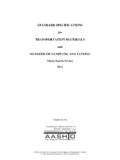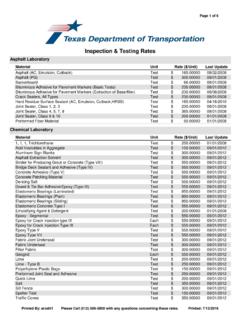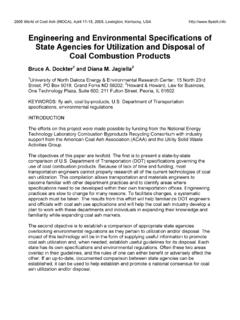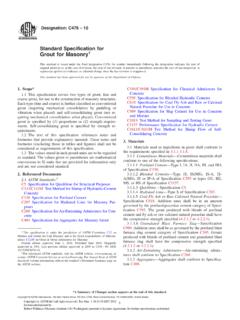Transcription of WHITE P APER Ultra˜ne Pumice Pozzolan for Glass Fiber ...
1 Cement and water hydration reaction must be accounted for in the mix design. And of concern for the GFRC industry is the loss of strength and ductility from the interaction of alkalinity in the hydrated cement paste with the very Glass bers used to provide the concrete composition with its multi-faceted strength. is deleterious e ect is overcome by using a Pozzolan in the mix design to reduce the overall alkali content and alter the pH of the concrete pore not just any Pozzolan will do. NEGA selected Hess UltraPozz as a product it endorses and distributes. is ultra ne natural Pumice Pozzolan meets these important criteria Color. A light-colored Pozzolan means panel designers are not limited on color options and can tightly control color consistency.
2 Hess UltraPozz is re ned from the whitest Pumice commercially available. (GE Brightness of 84). Consistency. Because GFRC panels and products are meant to be seen, look and performance is critical. Achieving such undeviating consistency is only possible with predictably performing component materials. Hess UltraPozz is carefully re ned to perform as expected, application a er e utility of Pumice as a high-performance Pozzolan is the result of its being formed and calcined by volcanic action. A er such a spectacular genesis, all that remains in the product-development process is to grind it to an ultra ne particle size, increasing the surface area and hence, its e ectiveness in mitigating the alkali byproducts formed in the hydration of Portland cement.
3 As Hess UltraPozz enjoys at-source bene ts of natural calcination, purity, and whiteness, the use-costs are quite attractive. e other side of the economy coin is that Hess UltraPozz can be added at a 25% replacement of Portland cement the cost of Pozzolan is o set by the savings from using less Portland cement. As an added bene t, the net carbon footprint (greenhouse gas emissions) for the nished concrete product this research especially the at-lining e ect Pumice pozz has on ASR was a factor in NEGA s decision to speci cally look at using Hess UltraPozz in their com-posite mix ultimately to become the exclusive distributor of Hess UltraPozz to the GFRC i n du s t r y.
4 E adoption of Hess UltraPozz as cost-e ective, high-performance supplementary cementitious material in GFRC products by a major player like NEGA has piqued the interest of others in the precast industry, all of whom have similar demands for economy, performance, brightness, and cement replacement. by Brian Jeppsen and Michael DriverContact Brian Jeppsen at Hess Pozz or Michael Driver at NEGA for information on utilizing, testing, or sourcing natural Pumice Pozzolan in your precast concrete in 1949, Nippon Electric Glass (NEG) now operates 11 subsidiaries in various countries and manufactures a wide spectrum of technical glasses, including architectural Glass , electronic Glass , Glass ceramics, LCD Glass , E ber, and Alkali Resistant (AR) Glass ber.
5 Ey successfully developed a high zirconia (ZrO2) alkali-resistant Glass ber in 1975 that is used widely to strengthen cement and concrete building products, and in particular, those classi ed as Glass Fiber Reinforced Concrete (GFRC). NEG not only provides alkali resis-tant Glass ber to the industry, they are also a supplier of Polyplex acrylic curing compound, Riteks SP7000 SCC admixture and Power-Sprays mixing, pumping and spraying equipment. In addition, NEGA provides training and technical support to GFRC Fiber Reinforced Concrete products are well known to the construction industry, as they provide a cost e ective way to add architectural interest and enduring performance to the most notable part of a building: the exterior cladding.
6 E utility of GFRC is not limited to sculpted strength of GFRC is also beautifully practical in creating durable faux-natural features such as rock formations and other landscaping elements. Statuary and other works of art are well served with GFRC, as is the need to recreate intricate ornamental features for historic renovation is a portland cement-based composite reinforced with randomly dispersed, alkali-resistant Glass bers. As the name implies, these bers add strength impact, tensile, and exural to the concrete, and that strength can be leveraged into making thin, lightweight architectural cladding panels for all types of buildings, both inside and out.
7 Imagination nds rare limitation in the design possibilities made practical by GFRC panels. e Need For PozzLike any construct or product that uses portland cement, a congenital performance vulnerability in the Improved DurabilityNatural Pumice Pozzolan also deals decisively with another issue that arises when using portland cement: porosity. Byproducts (calcium hydroxide) from the cement hydration process migrate out of the concrete composite as it cures, creating a maze of microscopic wormholes that not only a ect cured strength, but increase permeability and that permeability is an invitation to all kinds of unwanted chloride and sulfate attacks, e orescent surface staining, and freeze-thaw damage.
8 In short, the presence of calcium hydroxide subverts the tight impermeability concrete needs for longevity and performance. e Pozzolanic Reaction e pozzolanic reaction ignited by Hess UltraPozz consumes and repurposes the calcium hydroxide byproduct into bene cial compounds (primarily Calcium Silicate Hydrate) that help to tightly bind the aggregates and densely weld the concrete composite matrix. Permeability is signi cantly decreased, strength is ampli ed, and the life-span of the GFRC product goes way up. Research shows that density and strength continue to improve for months, even years, as the bene cial pozzolanic reaction will continue until the Pozzolan is used is important to note that the pozzolanic reaction with the alkali byproducts does not occur immediately, so it is necessary to use alkali-resistant, Glass bers with a zirconia content greater than or equal to 16% and meeting the speci cations outlined in ASTM C-1666.
9 WHITE PAPERU ltra ne Pumice Pozzolan for Glass Fiber Reinforced Concrete ProductsLike any construct or product that uses Portland cement, a congenital performance vulnerability in the cement and water hydration reaction must be accounted for in the mix SUMMARYG lass Fiber Reinforced Concrete (GFRC) panels and products are well established in the materials vocabulary of building design professionals. Although methods of GFRC manufacture vary, spraying a Glass - ber reinforced, cement-based composite onto a form of a desired shape and size and installing a light-gauge metal stud frame to support the GFRC skin is the most common. A typical GFRC panel consists of 5% (by weight of total mix) of alkali resistant Glass bers combined with a Portland cement/silica sand slurry and acrylic latex curing compoundIMPROVED PERFORMANCE WITH HESS Pumice POZZOLANIf moisture is present, the GFRC composite even with special alkali resistant Glass will lose some strength and ductility with time.
10 The leading theory to explain this phenomenon is that ongoing cement hydration results in deleterious compounds, primarily calcium hydroxide, that penetrate the ber bundles and ll the interstitial spaces between the Glass laments. This then increases the bond of the Glass ber to the cement matrix and leads to a reduction in ber pull out with a reduction in strain to failure and tensile strength. Working in concert, an alkali-resistant Glass ber (Nippon Electric Glass AR ber) and an alkali-killing supplementary cementitious material meeting ASTM C-618 type N speci cations (Hess UltraPozz) make the versatile beauty and lightweight strength of the GFRC product enduring and or E Glass bers that are used to reinforce plastics should never be used in GFRC.







